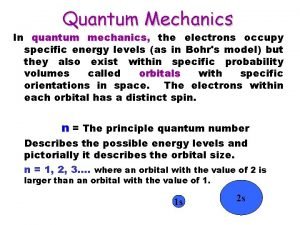Quantum Mechanics Quantum Mechanical Model of the Atom









- Slides: 9

Quantum Mechanics

Quantum Mechanical Model of the Atom • This is the current model of the atom (…ish) • Also includes an electron cloud • Electrons are moving in waves- not in orderly, straight paths.

Electron movement • In orbitals NOT ORBITS • Basketball court model • In a given region around the nucleus based on energy level

Structure of Energy Levels • Most broad: electrons are in atoms • Within atoms: there are Quantum Levels (n) • Within quantum levels: there are sublevels • S: 2 electrons in 1 orbital • P: 6 electrons in 3 orbitals • D: 10 electrons in 5 orbitals • F: 14 electrons in 7 orbitals • Where are they on the periodic table?

Number of sublevels in each quantum level • Follow the periodic table!! • n = 1 has only s • n = 2 has s and p The quantum levels do not always match up with the rows of the periodic table… • n = 3 has s, p, and d • n = 4 has s, p, d, and f

Notation • Electron configurations! • Break the configurations up by: • n (Quantum Level) • Sublevel (s, p, d, f) • Number of electrons within that sublevel (written as a superscript)

Electron configuration • The distribution of electrons among the sublevels of an atom. • ALWAYS letters and numbers • Fill out total number of electrons for each element shown on your notes page through B and Mn) (H

Orbital Diagrams • Orbital diagrams will always use boxes- these boxes show the orbitals in an atom. • Follow the sublevels, arrows for each electron • Try these: • Oxygen • Chlorine

Rules • Aufbau Principle (snake diagram) • You must fill a sublevel before moving on to the next one. The periodic order must be obeyed! • Pauli Exclusion Principle • A maximum of two electrons can share an orbital. If two electrons share the same orbital, they will have opposite spin. • Hund’s Rule (Roommate rule) • You must put one electron into each orbital before pairing them up.
 Quantum mechanical atom model
Quantum mechanical atom model Quantum mechanical atom model
Quantum mechanical atom model The p sublevel resembles the ______ shape.
The p sublevel resembles the ______ shape. Classical mechanics
Classical mechanics Quantum physics vs quantum mechanics
Quantum physics vs quantum mechanics Perkembangan model atom dalton
Perkembangan model atom dalton Niels bohr quantum mechanical model
Niels bohr quantum mechanical model Quantum atom model
Quantum atom model Quantum mechanical model labeled
Quantum mechanical model labeled Quantum mechanical model definition chemistry
Quantum mechanical model definition chemistry

















